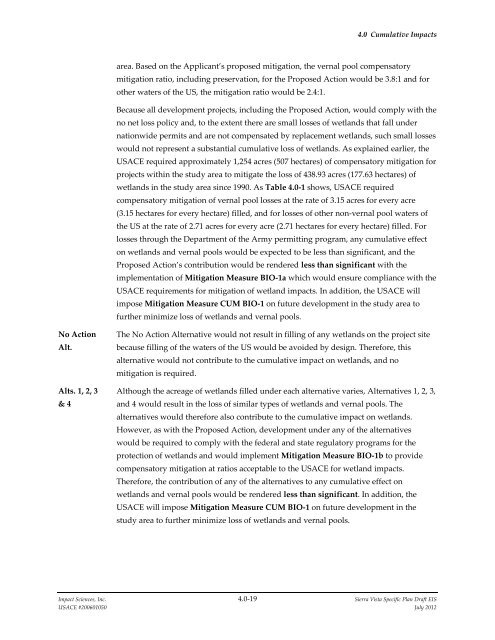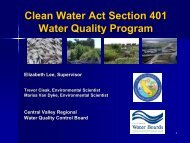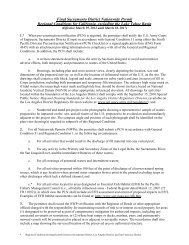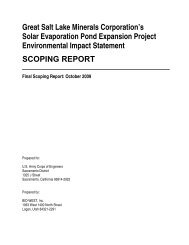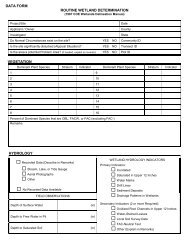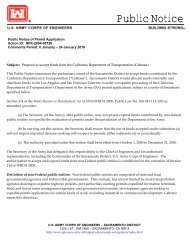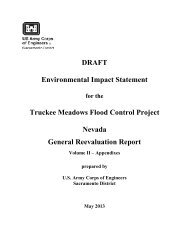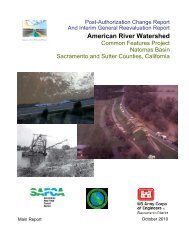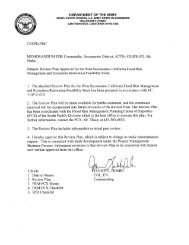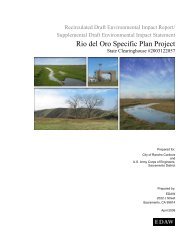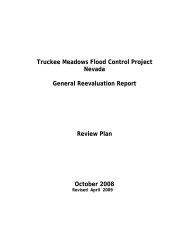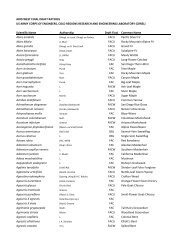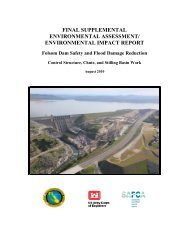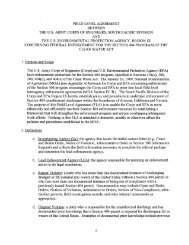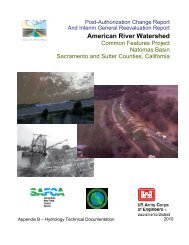4.0 CUMULATIVE IMPACTS - Sacramento District - U.S. Army
4.0 CUMULATIVE IMPACTS - Sacramento District - U.S. Army
4.0 CUMULATIVE IMPACTS - Sacramento District - U.S. Army
You also want an ePaper? Increase the reach of your titles
YUMPU automatically turns print PDFs into web optimized ePapers that Google loves.
<strong>4.0</strong> Cumulative Impacts<br />
area. Based on the Applicant’s proposed mitigation, the vernal pool compensatory<br />
mitigation ratio, including preservation, for the Proposed Action would be 3.8:1 and for<br />
other waters of the US, the mitigation ratio would be 2.4:1.<br />
Because all development projects, including the Proposed Action, would comply with the<br />
no net loss policy and, to the extent there are small losses of wetlands that fall under<br />
nationwide permits and are not compensated by replacement wetlands, such small losses<br />
would not represent a substantial cumulative loss of wetlands. As explained earlier, the<br />
USACE required approximately 1,254 acres (507 hectares) of compensatory mitigation for<br />
projects within the study area to mitigate the loss of 438.93 acres (177.63 hectares) of<br />
wetlands in the study area since 1990. As Table <strong>4.0</strong>-1 shows, USACE required<br />
compensatory mitigation of vernal pool losses at the rate of 3.15 acres for every acre<br />
(3.15 hectares for every hectare) filled, and for losses of other non-vernal pool waters of<br />
the US at the rate of 2.71 acres for every acre (2.71 hectares for every hectare) filled. For<br />
losses through the Department of the <strong>Army</strong> permitting program, any cumulative effect<br />
on wetlands and vernal pools would be expected to be less than significant, and the<br />
Proposed Action’s contribution would be rendered less than significant with the<br />
implementation of Mitigation Measure BIO-1a which would ensure compliance with the<br />
USACE requirements for mitigation of wetland impacts. In addition, the USACE will<br />
impose Mitigation Measure CUM BIO-1 on future development in the study area to<br />
further minimize loss of wetlands and vernal pools.<br />
No Action<br />
Alt.<br />
Alts. 1, 2, 3<br />
& 4<br />
The No Action Alternative would not result in filling of any wetlands on the project site<br />
because filling of the waters of the US would be avoided by design. Therefore, this<br />
alternative would not contribute to the cumulative impact on wetlands, and no<br />
mitigation is required.<br />
Although the acreage of wetlands filled under each alternative varies, Alternatives 1, 2, 3,<br />
and 4 would result in the loss of similar types of wetlands and vernal pools. The<br />
alternatives would therefore also contribute to the cumulative impact on wetlands.<br />
However, as with the Proposed Action, development under any of the alternatives<br />
would be required to comply with the federal and state regulatory programs for the<br />
protection of wetlands and would implement Mitigation Measure BIO-1b to provide<br />
compensatory mitigation at ratios acceptable to the USACE for wetland impacts.<br />
Therefore, the contribution of any of the alternatives to any cumulative effect on<br />
wetlands and vernal pools would be rendered less than significant. In addition, the<br />
USACE will impose Mitigation Measure CUM BIO-1 on future development in the<br />
study area to further minimize loss of wetlands and vernal pools.<br />
Impact Sciences, Inc. <strong>4.0</strong>-19 Sierra Vista Specific Plan Draft EIS<br />
USACE #200601050 July 2012


